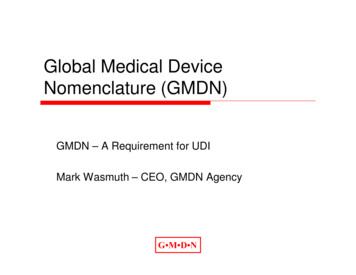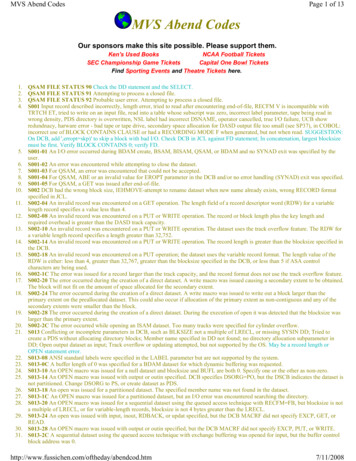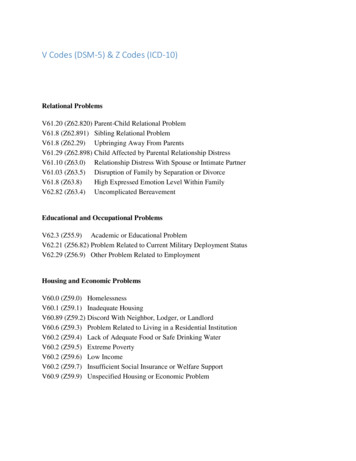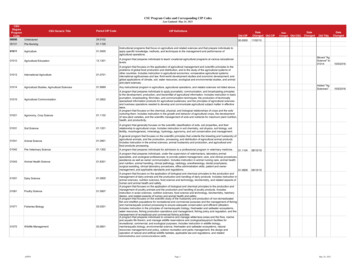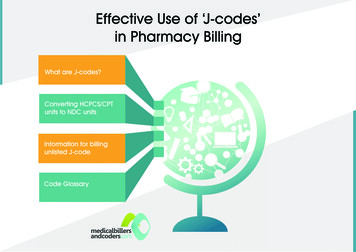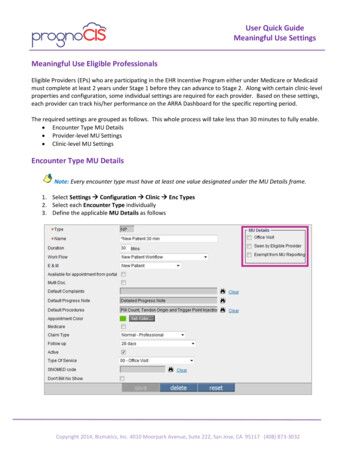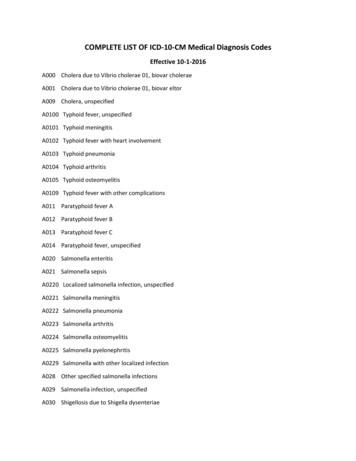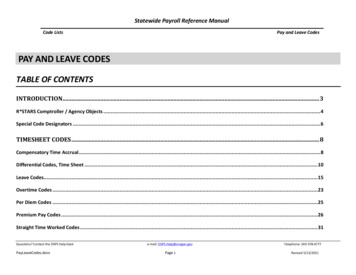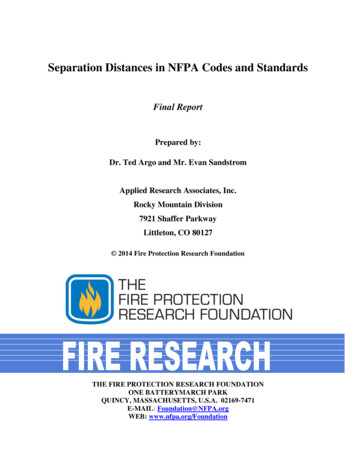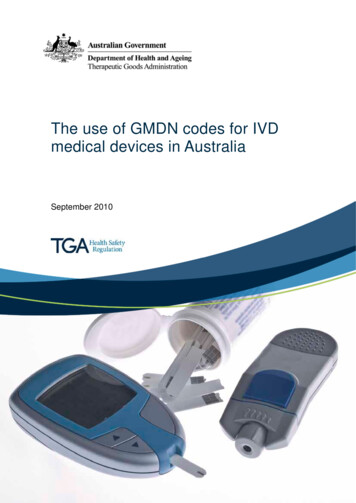
Transcription
The use of GMDN codes for IVDmedical devices in AustraliaSeptember 2010
Therapeutic Goods AdministrationAbout the Therapeutic Goods Administration (TGA) The TGA is a division of the Australian Government Department of Health and Ageing, and isresponsible for regulating medicines and medical devices. TGA administers the Therapeutic Goods Act 1989 (the Act), applying a risk managementapproach designed to ensure therapeutic goods supplied in Australia meet acceptable standardsof quality, safety and efficacy (performance), when necessary. The work of the TGA is based on applying scientific and clinical expertise to decision-making, toensure that the benefits to consumers outweigh any risks associated with the use of medicinesand medical devices. The TGA relies on the public, healthcare professionals and industry to report problems withmedicines or medical devices. TGA investigates reports received by it to determine anynecessary regulatory action. To report a problem with a medicine or medical device, please see the information on the TGAwebsite.Copyright Commonwealth of Australia 2010This work is copyright. Apart from any use as permitted under the Copyright Act 1968, no part may bereproduced by any process without prior written permission from the Commonwealth. Requests and inquiriesconcerning reproduction and rights should be addressed to the Commonwealth Copyright Administration,Attorney General’s Department, National Circuit, Barton ACT 2600 or posted at http://www.ag.gov.au/ccaThe use of GMDN codes for IVD medical devices in Australia,September 2010Page i
Therapeutic Goods AdministrationThe use of GMDN codes for IVD medical devicesin AustraliaThis sectionGlobal Medical Device Nomenclature (GMDN) . 3GMDN terminology . 4Use of GMDN codes for IVDs in Australia . 4Structure of GMDN terms for IVDs. 7Diagram of collective term structure . 7Level 1 collective terms . 8Level 2 collective terms . 9Level 3 collective terms . 11Level 4 preferred terms . 15Class 4 immunohaematology reagents (Class 4 IHRs) . 16Applying the correct GMDN Collective Term to your product . 16Frequently asked questions . 17Appendix 1 – Standard technologies and definitions . 19Non-immune based methods . 19Immune based methods . 21Appendix 2 – Collective term definitions and analytes . 23Clinical chemistry IVDs . 23Coagulation IVDs . 31General laboratoryware IVDs . 32Haematology IVDs . 35Histology and cytology IVDs . 37Human Genetics IVDs . 41Immunohaematology (blood banking) IVDs . 43Infectious disease IVDs . 45Instrument and analyser IVDs . 58Microbiological culture media IVDs . 59Software IVDs . 61Specimen receptacle IVDs . 62Tissue typing IVDs . 63Global Medical Device Nomenclature (GMDN)The GMDN is an international nomenclature system used by regional or nationalregulatory bodies to consistently describe medical devices 1. GMDN codes are used toassist in the: consistent assessment of devices before they are approved for supply ongoing monitoring of devices once they are available for supply.1The use of the term ‘medical device’ is taken to include ‘IVD medical devices’—the latter term will be used todenote references that are specific to IVD medical devices.The use of GMDN codes for IVD medical devices in Australia,September 2010Page 3 of 65
Therapeutic Goods AdministrationThe GMDN database is made up of a large number of generic device descriptorscalled preferred terms (PTs), each consisting of a term name, a definition and a unique5 digit code that is used to identify a particular medical device. The preferred termsare arranged within the GMDN database so that they are grouped together based onsimilar characteristics, using a system of collective terms (CTs). The GMDN databaseis maintained by a not for profit agency based in the United Kingdom, with assistancefrom various technical experts around the world.International regulatory authorities, including the TGA, liaise with the GMDNAgency to request amendments to existing codes and to create new codes. OtherGMDN users may also make requests for new codes to the GMDN Agency. For moreinformation please see the GMDN Agency website at www.gmdnagency.org .The structure of the terms for IVDs in the GMDN database is discussed in detail laterin this chapter.GMDN terminologyThe international standard ISO 15225:2010 Medical devices - Quality management Medical device nomenclature data structure provides definitions for the terminologyused by the GMDN Agency for referring to various terms used within the database.Descriptions of the different terms (ie preferred term, collective term) that are used inrelation to IVDs are also included throughout this guidance document to assist userswith understanding the nomenclature structure and its relevance.Use of GMDN codes for IVDs in AustraliaIVDs must be included in the Australian Register of Therapeutic Goods (ARTG) as a“kind of medical device”. This concept means that depending on the classification ofthe IVDs concerned, an entry in the ARTG may cover a range of products that are “ofthe same kind”, or it may cover a unique device type.As described in section 41BE of the Therapeutic Goods, 1989 (the Act), IVDs aretaken to be “of the same kind” as another IVD if they:- have the same sponsor; and- have the same manufacturer; and- have the same device nomenclature system code (i.e. GMDN code); and- have the same medical device classification; and- are the same in relation to any other characteristics described in theRegulations.Regulation 1.6 of the Therapeutic Goods (Medical Devices) Regulations 2002 (theRegulations) states that for the purposes of section 41BE (1) (e) of the Act, acharacteristic for Class 4 IVDs, other than Class 4 immunohaematology reagents(Class 4 IHRs), is the unique product identifier (UPI) given to the device by itsmanufacturer to identify the individual device type and any variants. Thus, from apractical perspective, only applications for Class 1, Class 2, Class 3 or Class 4 IHRIVDs can have multiple products included under a single ARTG application.The use of GMDN codes for IVD medical devices in Australia,September 2010Page 4 of 65
Therapeutic Goods AdministrationFor more information about kinds of IVD medical devices, including the details asprescribed in the legislation, please see Section – Including IVD medical devices inthe ARTG.The Regulations also describe specific device nomenclature codes that are to beapplied to certain medical devices, based on their risk classification.From the Therapeutic Goods (Medical Devices) Regulations2002 –1.7 Device nomenclature system codes (Act s41BE (3))(1)In accordance with the Global Medical Device Nomenclature System Code,as set out in ISO 15225:2000 (E), the device nomenclature code specified fora medical device is:(a)for a Class 4 IVD medical device –– the relevant preferredterm; and(b) for a Class 4 IVD medical device that is an immunohaematologyreagent IVD medical device –– the relevant Level 2 collective term;and(c)for a Class 3 IVD medical device –– the relevant Level 3collectiveterm, or if no Level 3 term exists, the relevant Level 2 collectiveterm; and(d)for a Class 2 IVD medical device –– the relevant Level 2collectiveterm; and(e) for a Class 1 IVD medical device or an export only IVD medicaldevice –– the relevant Level 1 collective.The manufacturer is responsible for applying the appropriate GMDN code to an IVDor a group of IVDs, as manufacturers have declared the intended purpose and are bestplaced to determine the correct GMDN code. For Class 4 IVDs, the manufacturermust specify the relevant GMDN preferred term code, which is the unique 5-digitcode used to identify the types of medical devices that perform similar or equivalentfunctions, or have characteristics in common. The preferred term code acts as thedefinitive reference for the preferred term name and definition, which for IVDs isgenerally based on the primary analyte or substance being tested for. Preferred termsare used to describe the generic nature of IVDs or their intended purpose, but do notreflect specific characteristics assigned by the manufacturer to a device type such asbrand or trade name.For Class 1, Class 2, Class 3 and Class 4 IHR IVDs, the legislation states that therelevant Level 1, Level 2 or Level 3 collective term must be specified. Collectiveterms are a set of hierarchical terms that collectively group together a number ofpreferred terms based on similar specified characteristics, and can be used to identifygroups, families or types of medical devices covered by a manufacturer’s qualitymanagement system. Collective terms may also be used to illustrate the scope ofThe use of GMDN codes for IVD medical devices in Australia,September 2010Page 5 of 65
Therapeutic Goods Administrationcertificates issued by Conformity Assessment Bodies (CAB), identify a range of skillsand general technological abilities for which a CAB has been approved and is soappointed by the relevant regulatory authority, or for the exchange of regulatoryinformation between regulatory authorities. GMDN collective term codes areidentified by ‘CT’, followed by 3 or 4 digits (for example, CT123 or CT4567).Information provided for each of the various levels of CTs ranges from broadlydescriptive information for Level 1 CTs, to more detailed analyte-specific informationfor Level 3 CTs. The use of collective terms in Australia allows for multiple products“of the same kind” to be included in a single entry in the ARTG.Preferred terms are applied to medical devices for the purposes of identification. Byutilising the one-to-many relationship of collective terms linked to multiple preferredterms in the GMDN database, specific collective terms have been selected from theGMDN database for use in an Australian-only context to identify IVDs “of the samekind” for the purposes of ARTG entry.For Class 4 IVDs, manufacturers must always specify in their Australian Declarationof Conformity the preferred term code that identifies each product. For Class 1, Class2 or Class 3 IVDs or for Class 4 IHRs, the manufacturer must provide the collectiveterm code that describes all products “of the same kind”. In line with the use ofGMDN codes internationally, manufacturers may also choose to include in theirDeclaration of Conformity the preferred term codes that are applied to each product ifthey wish to identify them separately.Sponsors are urged to seek the advice of the manufacturer and to obtain themanufacturer’s Declaration of Conformity before submitting an application to theTGA. This will enable the sponsor to verify that the GMDN codes have beencorrectly applied by the manufacturer and that for each of the collective termsspecified, only IVDs whose target analytes are detailed in Appendix 2 for the relevantrisk classification will be included in the impending application for inclusion.GMDN preferred term codes and collective term codes for identifying medicaldevices are available to registered TGA sponsors and manufacturers by logging on tothe TGA eBusiness Services (eBS) at http://www.ebs.tga.gov.au/ , and going to theGMDN look up tables. The hierarchical collective term structure, including thenames, codes, descriptors and a list of the target analytes or the name of all IVDscaptured by each Level 1, Level 2 and Level 3 CT are appended to this guidancedocument.Please note: For Class 4 IVDs, where there appears to be no relevant GMDNpreferred term in the GMDN database or code tables for a particularIVD, the Manufacturer is required to obtain a GMDN code suitable fordescribing their product. Please contact the TGA IVD team for adviceon how to obtain new GMDN IVD codes.The use of GMDN codes for IVD medical devices in Australia,September 2010Page 6 of 65
Therapeutic Goods AdministrationStructure of GMDN terms for IVDsThe GMDN database includes terms and descriptors for more than 25,000 medicaldevices. Terms are primarily linked to one of 16 device categories, one of which isCategory 06 – In vitro diagnostic medical devices (IVDs). All current terms within
code used to identify the types of medical devices that perform similar or equivalent functions, or have characteristics in common. The preferred term code acts as the definitive reference for the preferred term name and definition, which for IVDs is generally based on the primary analyte or substance being tested for. Preferred terms are used to describe the generic nature of IVDs or their .
